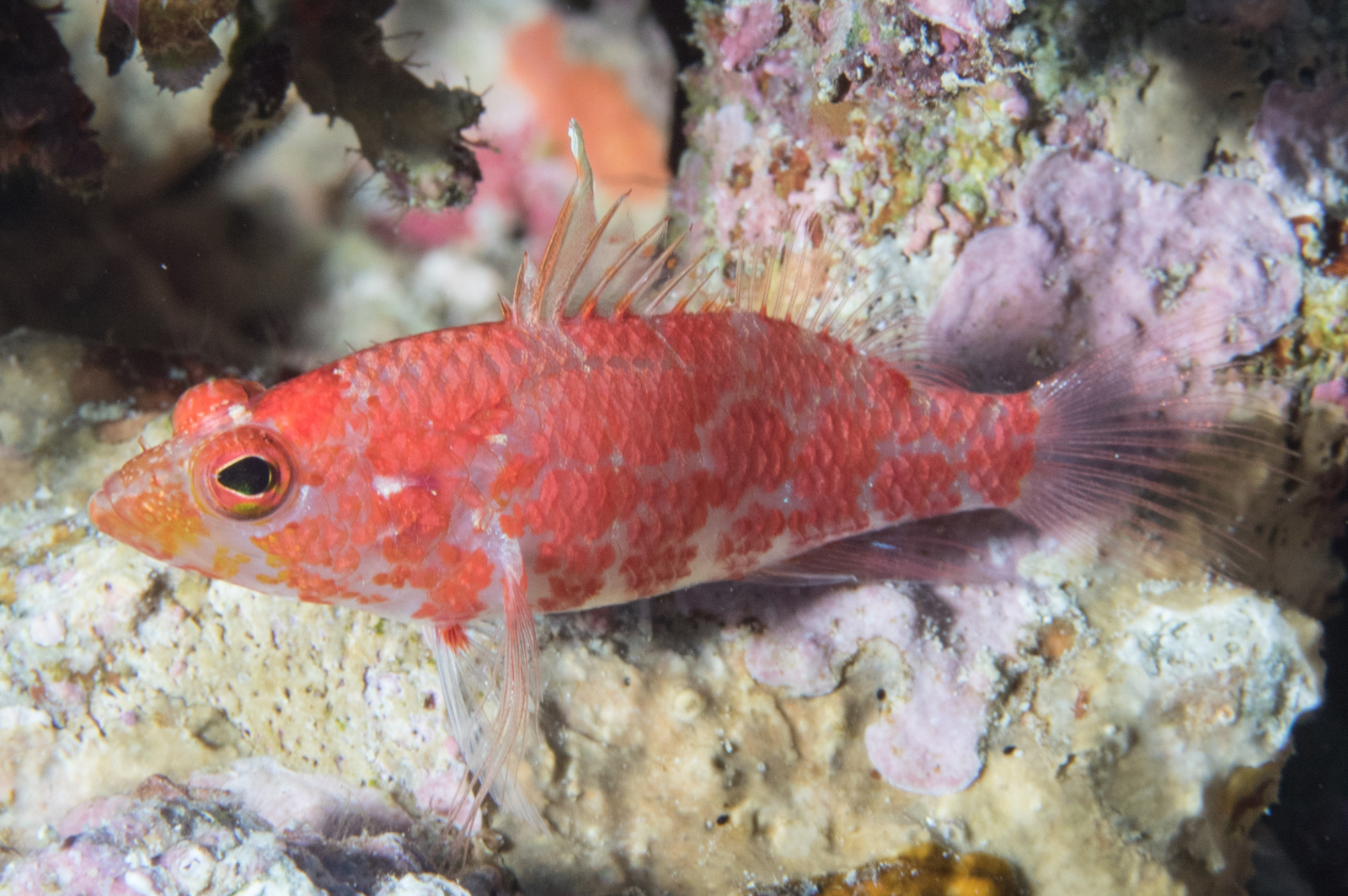Checkered Perchlet, Plectranthias inermis Randall 1980
Other Names: Geometric Hawkfish, Geometric Perchlet, Geometric Pygmy Hawk, Red Blotched Perchlet

A Chequered Perchlet, Plectranthias inermis, at Ra, Fiji, November 2017, depth 32m. Source: Mark Rosenstein / iNaturalist.org. License: CC By Attribution-NonCommercial-ShareAlike
Summary:
A perchlet with a red and white checkered pattern on the body that extends onto the posterior abdomen, anal-fin base and caudal peduncle.
Cite this page as:
Bray, D.J. 2021, Plectranthias inermis in Fishes of Australia, accessed 01 Jul 2025, https://fishesofaustralia.net.au/Home/species/5113
Checkered Perchlet, Plectranthias inermis Randall 1980
More Info
|
Distribution |
Known from the Australian territory of Christmas Island in the Eastern Indian Ocean. Elsewhere the species is widespread in the Indo-West Pacific: from Mauritius to Fiji. Inhabits deep coastal and inner reef drop-offs, usually sheltering among rubble or in crevices at the base of back-reef steep slopes. |
|
Features |
Dorsal fin X, 16-18; Anal fin III, 7; Pectoral fin 13, all rays unbranched; Gill rakers 5-6 + 10-12; Lateral-line incomplete, 12-22 tube scales in anterior series; Vertebrae 10+16. Third dorsal-fin spine the longest; antrorse spines on lower margin of preopercle absent; upper margin of preopercle not serrate or with only a few isolated weak serrae; 3 prominent flat spines on opercle. Pectoral fins very long, the longest rays reaching posterior to rear base of anal fin. |
|
Colour |
Fresh colour of holotype: white with large near-quadrangular blotches of orange-red in about three irregular rows on body, the red in the blotches concentrated in a spot on each scale; large blotches of the same color on nape, the largest beginning at origin of dorsal fin and passing two-thirds the distance to eye; small blotches of light red admixed with yellow on ventral half of head; first three membranes of spinous portion of dorsal fin pale yellowish; remaining membranes whitish with an outer row of yellow spots, one per membrane, and red distal tips; an orange-red spot basally on first, fifth, sixth, and eighth to tenth dorsal spines; soft dorsal whitish with pale pink rays and a faint yellowish stripe near base; caudal and anal fins whitish with pink rays, the anal with some yellow on spinous membranes and three orange-red spots at base; pectoral fin, transparent with pinkish rays; pelvic fins whitish on lateral edge with pink rays and a streak of yellow on the last three membranes; iris a mixture of light red and yellow. |
|
Similar Species |
The following combination of characters distinguishes Plectranthias inermis from congeners: segmented dorsal rays 16–18; third dorsal spine longest, 15.6–18.8 % SL; lateral line complete, interrupted or incomplete, consisting of 12–28 tubed scales; predorsal scales extend anteriorly to middle or posterior interorbital (at point ranging from vertical through posterior edge of orbit to vertical through middle of pupil); preopercle with 3–11 weak serrations on posterior (vertical) edge and 0–2 weak serrations on ventral edge (none antrorse). |
|
Etymology |
The specific name is from the Latin inermis (= unarmed), in reference to the lack of spines and serrae on preopercle, the small outer canine teeth of the upper jaw, and lack of canines in the lower jaw. |
|
Species Citation |
Plectranthias inermis Randall 1980, Micronesica 16(1): 135, fig. 11. Type locality: Southwestern side of Caban Island, Batangas, Luzon Island, Philippines. |
|
Author |
Bray, D.J. 2021 |
|
Resources |
Checkered Perchlet, Plectranthias inermis Randall 1980
References
Allen, G.R. & Erdmann, M.V. 2012. Reef fishes of the East Indies. Perth : Tropical Reef Research 3 vols, 1260 pp.
Allen, G.R. & Steene, R.C. 1988. Fishes of Christmas Island Indian Ocean. Christmas Island : Christmas Island Natural History Association 197 pp.
Allen, G.R., Steene, R.C. & Orchard, M. 2007. Fishes of Christmas Island. Christmas Island : Christmas Island Natural History Association 2 edn, 284 pp.
Gill, A.C., Pogonoski, J.J., Moore, G.I. & Johnson, J.W. 2021. Review of Australian species of Plectranthias Bleeker and Selenanthias Tanaka (Teleostei: Serranidae: Anthiadinae), with descriptions of four new species. Zootaxa 4918(1): 1-116. https://doi.org/10.11646/zootaxa.4918.1.1
Heemstra, P.C. 1996. A review of species of the Anthiine fish genus Plectranthias (Perciformes: Serranidae) from Mauritius. Trans. Roy. Soc. S. Afr. 51: 139-146.
Heemstra, P.C. & Randall, J.E. 2009. A review of the anthiine fish genus Plectranthias (Perciformes: Serranidae) of the Western Indian Ocean, with description of a new species, and a key to the species. Smithiana Bulletin 10: 3-17.
Kuiter, R.H. 2004. Basslets, Hamlets and their relatives. A comprehensive guide to selected Serranidae and Plesiopidae. Chorleywood, UK : TMC Publishing 1, 216 pp.
Kuiter, R.H. & Tonozuka, T. 2001. Indonesian Reef Fishes. Part 1. Eels- Snappers, Muraenidae - Lutjanidae. Australia : Zoonetics pp. 1-302.
Randall, J.E. 1980. Revision of the fish genus Plectranthias (Serranidae: Anthiinae) with description of 13 new species. Micronesia 16(1): 101-187. See ref online
Randall, J.E. 1996. Two new anthiine fishes of the genus Plectranthias (Perciformes: Serranidae), with a key to the species. Micronesica 29(2): 113-131 See ref online
Williams, J.T., Lawrence, A. & Myers, R. 2016. Plectranthias inermis. The IUCN Red List of Threatened Species 2016: e.T69588709A69592432. http://dx.doi.org/10.2305/IUCN.UK.2016-3.RLTS.T69588709A69592432.en. Downloaded on 07 January 2018.





